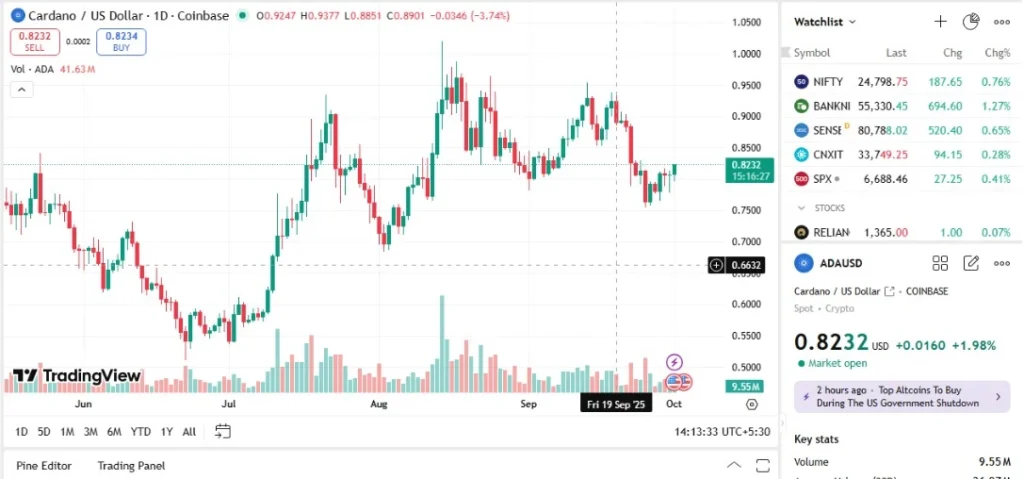Coinbase Lists Sui Futures as Cardano Rolls Out Bitcoin DeFi | Layer 1s Setting a New Direction

A busy week across layer-1s is setting a new tone for Q4. Coinbase announced that it will introduce Sui futures on its CFTC-regulated derivatives venue on October 20, providing funds with another way to express their views on a fast-growing network that has driven throughput and DeFi usage this year.
- Sui Futures: A New Hedge and Access Point
- Security First: Sui Taps Blockaid For Ecosystem-Wide Protection
- Market Structure Angle: Why A Single Contract Can Change Flows
- Developer Angle: Parallel Execution Meets Real Usage
- Policy and Access: Why the U.S. Rulebook Matters
- Cardano’s Counter-Move: Bringing Bitcoin Liquidity To DeFi
- Data Check: Sui’s On-Chain And Market Baselines
- Investor Angle: What To Watch Into And After Launch
- Media Pulse: How Coverage Has Framed The Week
- Conclusion
- Frequently Asked Questions About Cardano’s Bitcoin DeFi and Sui Futures on Coinbase
- How will Sui futures trade on Coinbase Derivatives?
- Why does a security partnership like Blockaid’s matter for adoption?
- What are the key Sui metrics to track post-listing?
- How would Cardano’s Bitcoin DeFi change things if it ships as described?
- Where does DPoS fit into these developments?
- Glossary of Key Terms
Sui Foundation, meanwhile, expanded its security stack through a partnership with Blockaid, a firm that simulates transactions and flags malicious patterns before they hit wallets. And Cardano founder Charles Hoskinson outlined a plan he calls Bitcoin DeFi, a 2025 push to let users transact and earn in Bitcoin while using Cardano’s infrastructure. These three threads point to one theme: a tighter loop between safer infrastructure, regulated access, and cross-asset liquidity.
That loop matters for Delegated Proof of Stake (DPoS) payment and settlement networks as well, since lower fraud and deeper hedging typically draw more stablecoin flows and tokenization pilots.
Sui Futures: A New Hedge and Access Point
Coinbase Derivatives is adding Sui Futures on October 20. The venue states that it focuses on accessible markets for institutions and qualified retail clients through futures commission merchant partners, and it has been rolling out smaller-sized contracts to lower capital requirements.
Futures on Sui give professional desks a tool to manage inventory, basis risk, and exposure without touching spot custody. Because the contracts sit under CFTC oversight, many compliance teams can engage more easily than on offshore venues.
For allocators already active in Bitcoin and Ether futures, the listing broadens the menu of alt-layer exposure while keeping operations inside standard futures workflows. Coinbase’s derivatives push follows its broader effort to bring more complex products into the U.S. under a rulebook investors recognize, a trend that typically increases liquidity and narrows spreads once market makers price the new line. The date also lands in earnings season, when risk budgets often reset, giving quants and macro funds a clean point to add or hedge Sui positions.
Security First: Sui Taps Blockaid For Ecosystem-Wide Protection
In addition to Futures, Sui Foundation’s partnership with Blockaid adds pre-transaction simulation, ecosystem-wide wallet protection, and threat intelligence to the network’s defense in depth. The approach tries to stop malicious airdrops, phishing, and contract exploits before users sign anything.
That reduces user-side risk, which is where many losses occur. The timing is notable, arriving as Sui user counts and on-chain activity rise, and a wider set of mainstream apps test the network. Security investments also map to institutional comfort. A platform that can demonstrate real-time monitoring and clean incident response tends to attract payment pilots, tokenized asset experiments, and consumer applications that cannot tolerate frequent exploit headlines.
ALSO READ: 67.9M ADA Worth $54.3M Exits Coinbase Into 4.19B Whale Wallet Without Delegation
Similar dynamics have helped DPoS-focused rails used for payments and settlement grow stablecoin volumes, since merchants prefer predictable operations and low fraud. The Blockaid deal signals Sui is competing on safety as much as speed, which often matters more to CFOs and compliance officers than peak transactions per second.
— Sui (@SuiNetwork) September 29, 2025
Market Structure Angle: Why A Single Contract Can Change Flows
A new futures line can shift how capital moves across spot, perps, and options. Basis traders will watch the gap between Sui’s spot price and the new listed contract, then build carry trades that fund market depth.
Miners or validators with token exposure can hedge emissions and unlock working capital instead of selling into rallies. Liquidity providers can lean on futures to warehouse directional risk and quote tighter on DEXs. In prior cycles, this pattern expanded participation beyond crypto-native funds.
Dedicated commodity and macro shops often require exchange-listed, regulated derivatives before they trade a new asset. With Sui, the same rule applies. If volumes build, index providers can include the contract in multi-asset baskets, which tends to attract systematic flows. That feedback loop, safer custody plus regulated hedges, is what pushed DPoS-aligned payment networks and stablecoin rails into mainstream money movement over the last two years. The key is clean market plumbing, not slogans.
Developer Angle: Parallel Execution Meets Real Usage
Sui’s pitch is technical. The chain uses the Move language and object-centric data model to enable parallel execution, which can drive low latency for certain transactions. The question for investors is adoption, not theory. Recent dashboards show steady growth in total value locked, DEX activity, and daily usage.
External trackers put Sui’s TVL around the low-to-mid billions with healthy weekly DEX turnover, while address and transaction counts have scaled toward mass-market levels. Those are the inputs that entice consumer apps, fintechs, and gaming projects. If developers can rely on predictable fees and fast finality, they can design onboarding flows that feel familiar.
The combination of a security-minded foundation and a derivatives listing extends that story. It signals a maturing ecosystem that supports builders with tools and users with protection. That is also where DPoS-style payment networks have excelled, offering consistent fees that developers can budget against. Builders want fewer surprises.
Policy and Access: Why the U.S. Rulebook Matters
The U.S. remains the deepest pool of institutional capital. Coinbase’s decision to expand CFTC-supervised crypto futures in the U.S. aligns with a slow thaw in policy risk. When products clear under a familiar regime, risk committees have fewer objections and can move faster.
That does not erase volatility or leverage risk, but it normalizes a path for participation. For Sui, the impact is optionality. U.S. investors can take exposure, hedge, or run relative-value trades across multiple venues without shifting entities offshore. Over time, this tends to compress funding costs and spread risk across more counterparties.
ALSO READ: Sui Tests Wearables, XDC Foresees $7T in Tokenization, and ARK Buys Tech Stocks
A similar process supported larger rails used for stablecoin settlement, including several DPoS ecosystems that rode regulatory clarity to extend payment use cases. Rules create pipes. Pipes move value. That is the machine investors care about when they approve new mandates.
Cardano’s Counter-Move: Bringing Bitcoin Liquidity To DeFi
Hoskinson’s message is direct. A 19-person team is building Bitcoin DeFi on Cardano, aimed at letting users transact in Bitcoin, pay fees in Bitcoin, and earn yield back in Bitcoin while using Cardano infrastructure. If delivered, that design would lower the frictions between the largest crypto asset and smart-contract apps. It could also deepen liquidity across bridges and custodial routes if security is handled with institutional standards.

ADA Key Technical levels (Source: TradingView)
For investors, the relevant lens is the addressable market. Unlocking even a small slice of Bitcoin’s idle holdings for lending, swaps, or tokenized collateral can change volumes across multiple chains. The caveat is execution. Cross-chain designs face attack surfaces and policy scrutiny. Still, the direction is clear, more pragmatic alignment between base-asset liquidity and programmability.
That is the same alignment that helped DPoS-leaning payment and tokenization networks pitch faster settlement for real-world assets. If Cardano reduces friction for Bitcoin users without adding risk, the market will notice.
Data Check: Sui’s On-Chain And Market Baselines
The following snapshot gathers public metrics investors often track while assessing the durability of a listing catalyst. Figures are rounded where appropriate.
| Metric | Latest figure |
| Sui TVL | ~$2.1B |
| Daily transactions | ~4.4M |
| Daily active addresses | ~1.2M |
| DEX volume, 24h | ~$589M |
| Perps volume, 24h | ~$96M |
| Stablecoin cap on Sui | ~$678M |
Investor Angle: What To Watch Into And After Launch
Three signposts will tell the story.
- First, open interest and basis on day one and week one. If the spread stabilizes near funding expectations and market makers quote tight markets, depth will build.
- Second, cross-venue liquidity. Watch how spot, perps, and the new futures interact on price discovery during volatility.
- Third, developer momentum. Listings only matter if real usage follows. Track TVL, daily addresses, and stablecoin settlement as merchants and apps test flows. If Blockaid’s controls reduce incidents and false approvals, user trust should rise. That is how stablecoin and tokenization pilots decide where to ship next. DPoS payment networks offer a useful comparison here.
Their steady fees and quick finality made them a default for remittances and micro-commerce. Suppose Sui can pair a similar experience with a deeper security layer and a regulated hedge in the U.S. In that case, the asset can sustain more institutional flow without forcing spot sales in risk-off sessions.
Media Pulse: How Coverage Has Framed The Week
Specialist outlets highlighted the concrete date for Sui futures and linked it to broader access through FCM partners. Others focused on Sui’s growth metrics and the network’s parallel execution pitch. Security writers zeroed in on the Blockaid tie-up, citing pre-transaction simulation and ecosystem-level defense.
Cardano headlines concentrated on the Bitcoin DeFi angle and the scale of the engineering effort behind it. Together, these lines form a cohesive narrative that is neither price-driven nor speculative. It is about infrastructure, safety, and liquidity pathways. Those are the same pillars that shaped the last leg of growth in DPoS-tilted payment rails, where compliance and user protection helped onboard non-crypto businesses.
Investors reading across these sources will find a consistent takeaway: the market is rewarding projects that solve operational pain points and offer institutional guardrails.
ALSO READ: TRON Sets New Records in USDT Transfers as Sui Activates Google Payment Agents
Conclusion
The week’s signals are practical. Coinbase added a date for Sui futures, giving global funds a regulated way to manage risk and run strategies around a fast-scaling layer-1. Sui Foundation layered in Blockaid to stop common attack paths before users click, a choice that supports consumer and enterprise use cases.
Cardano set out a plan to bridge Bitcoin liquidity into DeFi, a move that could reshape volumes if security and operations meet institutional standards. The connective tissue is strong market plumbing, safer endpoints, and rule-of-law access. Those are the same features that helped DPoS-driven payment and tokenization networks win merchants and remitters over the last two years. If these projects sustain delivery, the next leg higher in usage will come from simple things, clean security, regulated hedges, and apps that run without drama.
Frequently Asked Questions About Cardano’s Bitcoin DeFi and Sui Futures on Coinbase
How will Sui futures trade on Coinbase Derivatives?
They will be listed under CFTC oversight through Coinbase’s derivatives venue and will be accessible via approved FCM partners. The contracts are part of a suite that includes smaller lot sizes designed to lower capital requirements for qualified retail and institutional.
Why does a security partnership like Blockaid’s matter for adoption?
Most losses occur at the user interface, not only in protocol code. Simulation and ecosystem-wide wallet protections reduce approval mistakes and block common attack paths. Lower incident rates support merchant and consumer apps that need predictable operations.
What are the key Sui metrics to track post-listing?
Monitor open interest on the futures, spot and perp depth, daily active addresses, TVL, and stablecoin settlement on Sui. Rising usage alongside stable derivatives funding is a healthy sign.
How would Cardano’s Bitcoin DeFi change things if it ships as described?
Direct Bitcoin transacting and yield within Cardano apps could pull fresh liquidity into smart-contract use cases. Execution and security are the hurdles. If solved, it shortens the path from passive BTC to on-chain activity.
Where does DPoS fit into these developments?
DPoS networks have grown as payment rails because of fast finality and predictable fees. Better security and regulated hedges, like Sui’s Blockaid tie-up and U.S. futures, tend to amplify those strengths across the broader market, even for chains that use other PoS variants.
Glossary of Key Terms
- CFTC: U.S. regulator that oversees futures and derivatives markets.
- FCM: Futures commission merchant, a broker that provides client access to futures venues.
- Basis: Difference between futures price and spot price for the same asset.
- Open Interest: Total outstanding futures contracts that have not been closed.
- Perpetuals: Futures without expiry that use funding payments to track spot.
- Parallel Execution: Processing many transactions at once instead of serially.
- Pre-transaction Simulation: A tool that previews what a contract will do before signing.
- TVL: Total value locked in DeFi applications on a chain.
- Stablecoin Settlement: Payments and transfers using dollar-pegged tokens.
- DPoS: Delegated Proof of Stake, a governance model that selects a limited set of validators to produce blocks.




